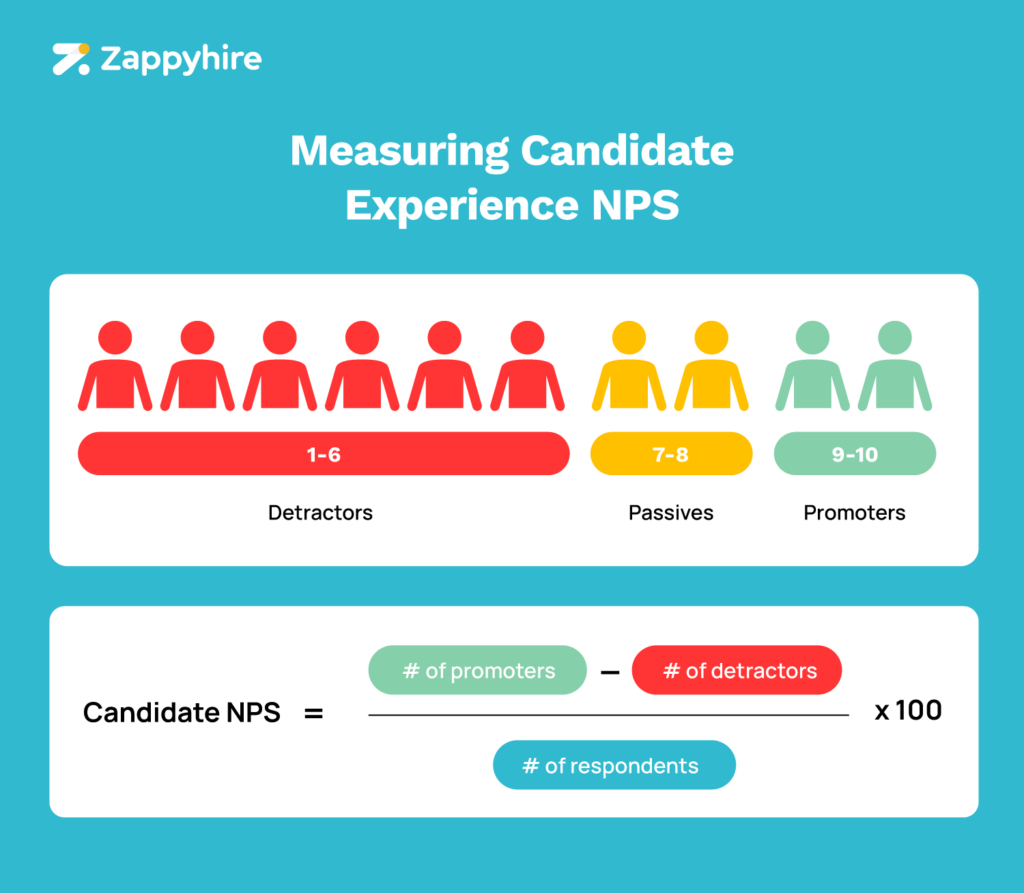
The candidate experience has become one of the most important aspects of hiring because it directly impacts how candidates perceive your company, whether they are hired or not.
Positive candidate experiences attract top talent and enhance your employer brand, while a poor experience can lead to negative reviews and missed opportunities.
But how do you measure candidate experience effectively? That’s exactly what we break down in this article. But first,
Why does measuring candidate experience (cNPS) matter?
A positive candidate experience does more than just leave candidates with a good impression – it’ll create a ripple effect on your organization.
Research shows that companies with positive candidate experiences are 3x more likely to improve employee retention.
Plus, they’re 2x more likely to see a boost in employee performance and NPS.
In other words, how you treat candidates during the hiring process can impact your long-term success.
However, despite its importance, many companies aren’t tracking candidate satisfaction.
In fact, only 11% of organizations actively track cNPS, which means a lot of businesses are missing out on opportunities to improve.
Tracking cNPS can help you pinpoint what’s working and what’s not, and gauge how candidates feel about their interactions with your company during the hiring process.
How to measure candidate NPS
Measuring cNPS helps identify whether your candidates would recommend your company to others based on their experience. Here’s a step-by-step breakdown on how to do it!
1. Send surveys after key steps
After candidates go through the application or interview process, send them a short survey asking, “On a scale from 0 to 10, how likely are you to recommend our company to others based on your experience?”
This question allows you to categorize respondents into three groups:
- Promoters (9-10) – Candidates who had an excellent experience and are likely to recommend the company.
- Passives (7-8) – Candidates who are neutral or mildly satisfied (aka not indifferent but not enthusiastic either).
- Detractors (0-6) – Candidates who had a negative experience and wouldn’t recommend your company.
But shockingly, only 21% of candidates have been surveyed about their satisfaction with the hiring process. Yet, gathering this feedback is essential to understanding where improvements are needed..!
2. Calculate your NPS
To calculate your cNPS, subtract the percentage of detractors (those who rate their experience between 0-6) from the percentage of promoters (those who give a rating of 9 or 10).
Passives, or those who rate between 7-8, are neutral and don’t count toward the final score.

For example, if 60% of candidates are promoters and 20% are detractors, your cNPS would be 40.
A positive score means more candidates are having good experiences than bad ones, but there’s always room for improvement.
3. Analyze the feedback
Once you have your cNPS, take a close look at the feedback you received.
What are candidates saying about your process? Are there common pain points, like long wait times or unclear communication? These insights will help you identify areas where you can make quick improvements.
Look for recurring issues in communication, timing, or the application process.
Surprisingly, 36% of candidates report waiting 1-2 months for updates after applying, which is a huge frustration.
Plus, 65% of candidates experience inconsistent communication, which leads to a lack of trust in the hiring process for 82% of applicants.
Communication is a BIG factor in candidate satisfaction, and small changes can make a big difference.

4. Track progress over time
Measuring cNPS isn’t a one-time thing.
It’s important to track your score over time to see how your changes are impacting candidate satisfaction.
Keep an eye on trends, make it a part of your employer branding, set benchmarks and goals, and continuously refine your recruitment process based on candidate feedback.
This is essential because improving your cNPS can have a direct impact on your employer branding strategy and long-term hiring success.
How to improve candidate experience NPS
Once you’ve measured your cNPS, the next step is making changes to improve it. Here are some proven strategies that can help!
1. Keep candidates in the loop
Lack of communication is one of the biggest complaints from candidates.
Many report feeling left in the dark about what happens next, with 65% of candidates saying they experienced inconsistent communication.
To fix this, make sure you’re keeping candidates in the loop at every stage of the process.
Whether it’s through automated emails or personal updates, clear communication helps build trust and improve the candidate experience by a lot.
2. Respect their time at every step
No one likes to be kept waiting, especially during a job search.
Long delays can make candidates lose interest or trust in your company.
Keep your process efficient, and don’t leave candidates hanging. Respond to applications and schedule interviews promptly.
Make use of automation and technology wherever possible. For example, pre-recorded video interviews can enhance candidate experience by a mile!
If a decision is taking longer than expected, give candidates a quick update so they know where they stand.
3. Always provide meaningful feedback
A little feedback can go a long way.
Research shows that finalists who receive feedback are 30-50% more likely to refer others to your company, even if they didn’t get the job.
By offering constructive feedback, you leave candidates with a positive impression of your company.
Plus, 70% of candidates said that receiving a clear reason for why they weren’t selected would improve their view of the company.
4. Personalize the experience
Even in a world of automation, candidates want to feel like they’re more than just a number.
Personalizing your interactions – whether it’s through customized emails or addressing specific points during interviews – can help candidates feel valued.
A personal touch goes a long way in leaving a lasting positive impression.
The bigger picture
Improving your cNPS isn’t just about making candidates happy – it’s about creating long-term benefits for your company.
Positive candidate experiences don’t just result in better hires – they improve retention, performance, and even your overall employer branding.
In fact, companies that provide great candidate experiences are significantly more likely to see improvements in other areas, like employee engagement and productivity!
A good candidate experience doesn’t end when the job is filled – it’s something that stays with candidates, shaping their views of your company and influencing their recommendations to others.
So, take the time to measure, analyze, and improve, and you’ll see the benefits in your talent pool and beyond!






